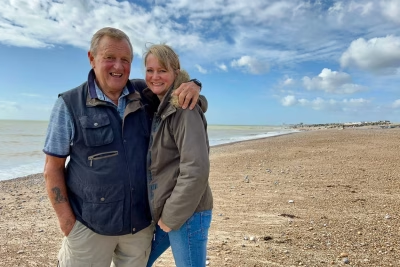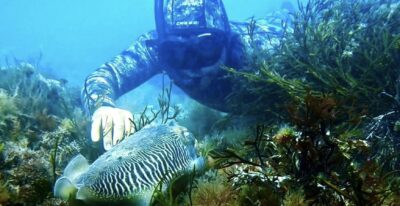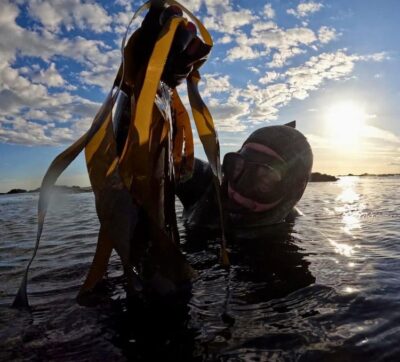August 1, 2024
A window beneath the waves: Sussex Underwater
BY: Sophie Fresson
Topics: Habitat Protection
Sussex Underwater is a group of divers, beachgoers & sea lovers documenting the remarkable recovery of Sussex’s inshore waters since trawling was banned in 2021 to help once vast kelp forests recover. We spoke to Catrine Priestley, ocean protector and manager of Sussex Underwater to find out more. Our ocean is astonishing and it can bounce back, if we let it. That’s why we’re calling for a ban on bottom trawling in all UK marine protected areas. Join us! Email the UK Environment Secretary here to help us get a ban.

Q: What’s your connection to Sussex Bay?
My connection is through my father, Eric Smith, who’s been diving in the bay since he was 11. He’s now 76, bless him – it’s been a long time! So I grew up knowing all about the bay and the beautiful kelp forests that were there at the time, and the sea life that used it as a nursery. I started diving there again a few years ago, and I’ve been lucky to see firsthand the wildlife returning since the trawling ban.
Q: Why is eyewitness testimony important in understanding the impact of bottom trawling and the subsequent recovery?
When my dad talks about the damage done by trawling, he’s seen that firsthand. He’s an eyewitness to the destruction.
But he’s also seen what existed before, when Sussex Bay was a Garden of Eden. Through his stories we can understand how it once was. Which is vital, because as humans we often get used to things as they are now, and we forget what’s actually been lost. We must listen to those who remember.
And when protective measures are put in place, we need to see the recovery with our own eyes to understand the full impact. We must go beneath the waves and create a visual record, which is what we’re doing at Sussex Underwater. We’re showing people the thriving marine life that’s returning, like mussel beds, electric rays, and even angel sharks.
Q: How did Sussex Underwater start, and who are they?
Sussex Underwater began after my dad’s part in the successful campaign for the trawling ban. He and his diving colleagues formed the group to protect the area and ensure trawling wouldn’t return. They wanted to make sure the sea would never be out of sight and out of mind. We believe that if we show people what’s there, they will start to understand it. Then they have a chance to fall in love with it. And if you fall in love with it, you’ll want to protect it.

Q: What evidence of recovery have you seen since the ban?
Our divers are tracking the bay’s recovery, and one very exciting find has been the resurgence of the mussel beds. The beds are vital as they bind the seabed back together and provide a base for the kelp forests to grow from. This is especially important for the bay, which had been so heavily trawled the seabed had disappeared and was essentially just bedrock.
My dad’s discovery of the first mussel patch was a Eureka moment for us. It has expanded from a tiny patch in that first year since the ban, then up to an area the size of a football pitch, and now to mussels going on as far as the eye can see. It’s been really exciting. We’ve also seen the return of lovely and unusual species, like the electric ray and sunfish. We’re re-building a whole ecosystem from the ground up.

Q: You’re a diver too?
I am now! When Sussex Underwater began, I helped to edit the videos. From the footage, I fell in love with the bay’s wildlife and it inspired me to start diving again. My return to diving was documented as part of the film Our Sea Forest (BBC iPlayer), showcasing the legacy passed down from my dad. Diving is now a very mindful experience for me and gives me that connection to our blue spaces.
Q: How do you bring the underwater world to those who can’t dive?
At Sussex Underwater, we aim to bring the bay’s beauty into people’s homes through our footage. We describe ourselves as a “window beneath the waves,” showcasing the marine life and making it accessible through social media and school talks. Engaging the community is vital for future marine conservation efforts, especially children as they’re the next generation of ocean protectors.
Q: What’s next for Sussex Underwater?
We, like Oceana, want to see bottom trawling banned in all MPAs across the UK. Many people don’t realise these areas aren’t fully protected, and trawling can still occur. So we want to work with other organisations, like yourselves, to raise awareness about how destructive trawling is, that it’s allowed in most of our protected waters, and push for sustainable fishing. Locally, we want to keep informing the Sussex community about the importance of the trawling ban.
Q: Are you hopeful about protecting and restoring marine areas?
I believe that if the government listens to marine organisations and properly protects MPAs, we have a chance. The goal of protecting 30% of marine areas by 2030 is ambitious but it’s still achievable. And if anything, I think we can go even further than that to preserve our marine environments. We really can. Because we need to; we need to save what we’ve got.
